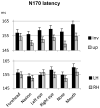Early sensitivity for eyes within faces: a new neuronal account of holistic and featural processing
- PMID: 24768932
- PMCID: PMC5321665
- DOI: 10.1016/j.neuroimage.2014.04.042
Early sensitivity for eyes within faces: a new neuronal account of holistic and featural processing
Abstract
Eyes are central to face processing however their role in early face encoding as reflected by the N170 ERP component is unclear. Using eye tracking to enforce fixation on specific facial features, we found that the N170 was larger for fixation on the eyes compared to fixation on the forehead, nasion, nose or mouth, which all yielded similar amplitudes. This eye sensitivity was seen in both upright and inverted faces and was lost in eyeless faces, demonstrating it was due to the presence of eyes at fovea. Upright eyeless faces elicited largest N170 at nose fixation. Importantly, the N170 face inversion effect (FIE) was strongly attenuated in eyeless faces when fixation was on the eyes but was less attenuated for nose fixation and was normal when fixation was on the mouth. These results suggest the impact of eye removal on the N170 FIE is a function of the angular distance between the fixated feature and the eye location. We propose the Lateral Inhibition, Face Template and Eye Detector based (LIFTED) model which accounts for all the present N170 results including the FIE and its interaction with eye removal. Although eyes elicit the largest N170 response, reflecting the activity of an eye detector, the processing of upright faces is holistic and entails an inhibitory mechanism from neurons coding parafoveal information onto neurons coding foveal information. The LIFTED model provides a neuronal account of holistic and featural processing involved in upright and inverted faces and offers precise predictions for further testing.
Keywords: Eye-tracking; Eyes; Faces; Holistic; Inversion; N170.
Copyright © 2014 Elsevier Inc. All rights reserved.
Figures







Similar articles
-
Increased Early Sensitivity to Eyes in Mouthless Faces: In Support of the LIFTED Model of Early Face Processing.Brain Topogr. 2018 Nov;31(6):972-984. doi: 10.1007/s10548-018-0663-6. Epub 2018 Jul 9. Brain Topogr. 2018. PMID: 29987641
-
One versus two eyes makes a difference! Early face perception is modulated by featural fixation and feature context.Cortex. 2018 Dec;109:35-49. doi: 10.1016/j.cortex.2018.08.025. Epub 2018 Sep 8. Cortex. 2018. PMID: 30286305
-
Species sensitivity of early face and eye processing.Neuroimage. 2011 Jan 1;54(1):705-13. doi: 10.1016/j.neuroimage.2010.07.031. Epub 2010 Aug 1. Neuroimage. 2011. PMID: 20650321 Free PMC article.
-
From eye to face: The impact of face outline, feature number, and feature saliency on the early neural response to faces.Brain Res. 2019 Nov 1;1722:146343. doi: 10.1016/j.brainres.2019.146343. Epub 2019 Jul 20. Brain Res. 2019. PMID: 31336099
-
Fixation location on upright and inverted faces modulates the N170.Neuropsychologia. 2014 May;57:1-11. doi: 10.1016/j.neuropsychologia.2014.02.006. Epub 2014 Mar 4. Neuropsychologia. 2014. PMID: 24607846
Cited by
-
Insights into the relationship between eye movements and personality traits in restricted visual fields.Sci Rep. 2024 May 4;14(1):10261. doi: 10.1038/s41598-024-60992-w. Sci Rep. 2024. PMID: 38704441 Free PMC article.
-
Differential age-related changes in N170 responses to upright faces, inverted faces, and eyes in Japanese children.Front Hum Neurosci. 2015 Jun 2;9:263. doi: 10.3389/fnhum.2015.00263. eCollection 2015. Front Hum Neurosci. 2015. PMID: 26082700 Free PMC article.
-
Perceived Gaze Direction Differentially Affects Discrimination of Facial Emotion, Attention, and Gender - An ERP Study.Front Neurosci. 2019 May 24;13:517. doi: 10.3389/fnins.2019.00517. eCollection 2019. Front Neurosci. 2019. PMID: 31178686 Free PMC article.
-
Understanding the role of eye movement pattern and consistency during face recognition through EEG decoding.NPJ Sci Learn. 2025 May 12;10(1):28. doi: 10.1038/s41539-025-00316-3. NPJ Sci Learn. 2025. PMID: 40355483 Free PMC article.
-
Face masks are less effective than sunglasses in masking face identity.Sci Rep. 2023 Mar 15;13(1):4284. doi: 10.1038/s41598-023-31321-4. Sci Rep. 2023. PMID: 36922579 Free PMC article.
References
-
- Barton JJS, Radcliffe N, Cherkasova MV, Edelman J, Intriligator JM. Information processing during face recognition: The effects of familiarity, inversion, and morphing on scanning fixations. Perception. 2006;35(8):1089–1105. - PubMed
-
- Batki A, Baron-Cohen S, Wheelwright S, Connellan J, Ahluwalia J. Is there an innate gaze module? Evidence from human neonates. Infant Behavior and Development. 2000;23(2):223–229.
Publication types
MeSH terms
Grants and funding
LinkOut - more resources
Full Text Sources
Other Literature Sources
Medical
Molecular Biology Databases

